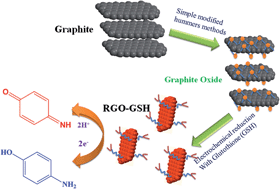Preparation of a reduced graphene oxide/poly-l-glutathione nanocomposite for electrochemical detection of 4-aminophenol in orange juice samples
Abstract
A novel electrochemical sensor, for the detection of 4-aminophenol (4-AP), was generated by electrodeposition of poly-L-glutathione (P-L-GSH) onto reduced graphene oxide (RGO) to form a RGO/P-L-GSH composite matrix on a glassy carbon electrode (RGO/P-L-GSH/GCE). The morphology and structure of the RGO/P-L-GSH modified GCE were characterized by scanning electron microscopy (SEM), FT-IR spectroscopy and electrochemical impedance spectroscopy. As an electrochemical sensor, the RGO/P-L-GSH modified GCE composite exhibited strong catalytic activity toward the oxidation of 4-AP which was demonstrated by cyclic voltammetry (CV) and chronoamperometry. Furthermore, the electrochemical sensor exhibited an excellent current response for 4-AP over a wide linear range of 0.4 μM to 200 μM (R2 = 0.9934) with a lower detection limit (LOD) of 0.03 μM (S/N = 3), as well as a sensitivity of 27.2 (μA μM−1 cm−2) and excellent selectivity, reproducibility and stability. The electrochemical sensor provides good anti-interference ability in the presence of glucose, fructose, paracetamol, ethanol, L-isoleucine, L-histidine, L-cysteine, dopamine, L-serine, L-tyrosine, phenylalanine, urea, hydrogen peroxide, K+, Ca2+, Na+, F−, Cu2+, Fe3+, Zn2+, SO42−, SO32−, Cl−, folic acid and ascorbic acid. The proposed electrochemical method was successfully applied to produce a sensor for the detection of 4-AP in juice and water samples.


 Please wait while we load your content...
Please wait while we load your content...